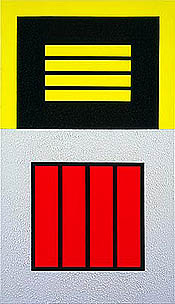May 7, 2004

Peter Halley, Horizontal Prison, Prison, 2004, Mary Boone Gallery
In Unspoiled Monsters, Truman Capote recounts a Parisian studio visit in which the salonista Nathalie Barney takes Alice B. Toklas to the atelier of the late Romaine Brooks, some time after the war.
Miss Barney has preserved everything as it was, from the velvet drapes to the smell of cat urine on the stairway. When Nathalie lets in some daylight, she and her spidery guest behold a series of gloomy, defiant portraits of the great lesbians of 1920s’ Paris, including Gertrude Stein.
“Romaine was a very limited artist,” Miss Toklas sniffs, according to Capote.
“Romaine was limited, yes,” Miss Barney replies, “but Romaine was a very great artist.”
Testing the greatest of limits and the limits of greatness, a veteran, Peter Halley, and an ingnue, Hilary Harkness, opened shows under the Mary Boone banner this month.
Uptown, the acolytes were almost as scarce as those chez Ms. Brooks for Halley’s exhibition of twee prison paintings, harking back to the breakthrough jail pieces which tempted collectors Barbara and Gene Schwartz back in 1987.
It was heartbreaking, tragic in a minor key, to behold these tiny formally executed wisps of yellow, pink and black by a painter who has devoted years to painstakingly building up his credentials like so many sand castles, while his body of work collapsed into a sameness and repetition destroying all sense of individuation from piece to piece.
That Halley can devote a few thousand words in the May issue of Artforum to minute exegeses of several obscure British fashion magazines, while being incapable of perceiving the sloggy despond of his own indistinguishable oeuvre is sad, if not puzzling.
He is indeed a prisoner of his own humorlessness and earnest self-aggrandizement. That said, these paintings have a savage cuteness burnished by the Boone imprimatur of stale couture. Halley remains, after so many years, an artist staring through the lock without realizing that the key is in his pocket.
Meanwhile, at her Chelsea space, Mary Boone highlights three small paintings by another Yalie, Hilary Harkness, in a sea of sepulchral whiteness which includes a long, blank wall.
Ms. Harkness, trained in the Midwest as a violinist, has beautiful long tapered fingers which resemble the tiny, joyless female vampires who torture each other in her virulently kitschy paintings.
The product of the artist’s labored fantasies about World War II sailors sunken and reincarnated as predatory lesbian zombies, these meticulously crafted mementos are vessels of suffocating lust, which collectors snap up like flies on a frog’s tongue.
Nevertheless, their locked-in soulless quality is as imprisoned as the bastilles of Halley.
We are beholding two artists chained to their paintings and alienated from life. To be sure, they have their antecedents in the late de Chirico and the last of Munch, in Ivan Albright, Lucas Samaras and Romaine Brooks.
Halley and Harkness, imprisoned, reify their self-imposed limits as artists and until they liberate themselves, only in their own minds are they great. Their self-regard as artists, technically impeccable and psychologically tormented, festers into a deep, dark, wound.
May the Muses grant them grace.
Peter Halley, May 1-June 26, 2004, at Mary Boone Gallery, 745 Fifth Avenue, New York, N.Y. 10151
Hillary Harkness, May 1-June 26, 2004, at Mary Boone Gallery, 541 W. 24th Street, New York, N.Y. 10011



